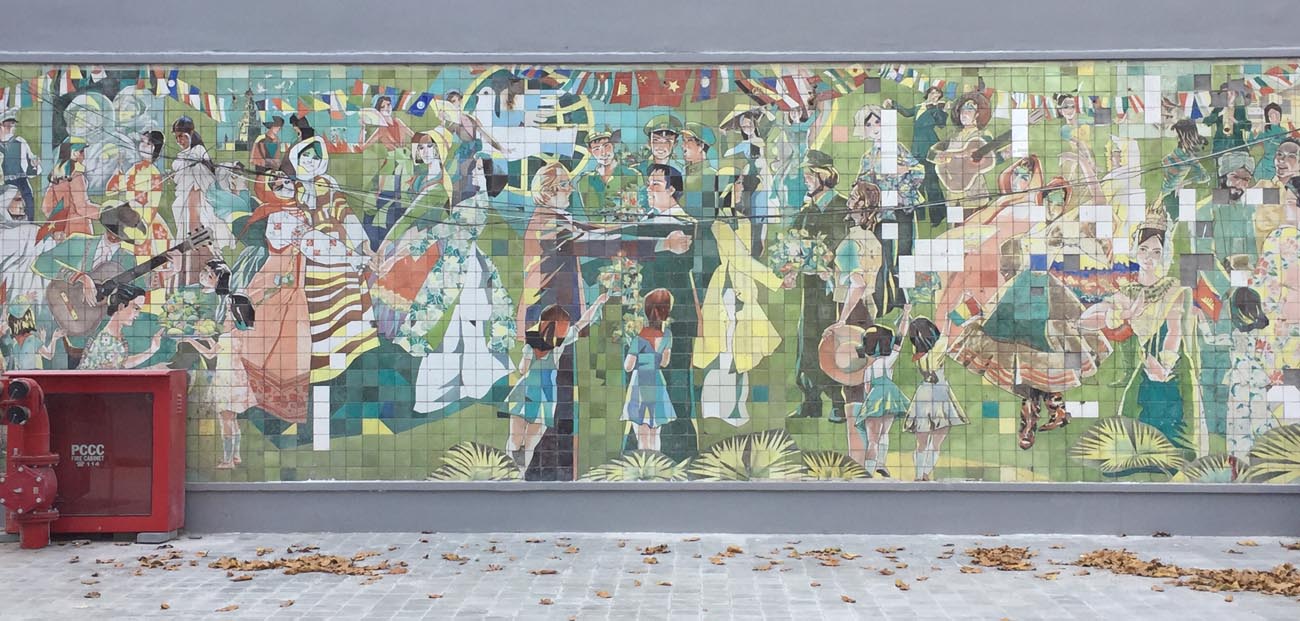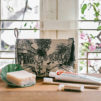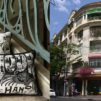
I am trying to unravel the story behind a beautiful hand-painted mosaic wall in Ho Chi Minh City. It seemed as though one moment it was there and then, with a blink of the eye, it was gone. It has the makings of a good mystery novel – we have the main character (the artist), the setting (a wall on the corner of Le Duan and Le Van Huu in downtown District 1), the plot (based around an intriguing mosaic) and the problem (where had it gone?). We just don’t have a solution, although I suspect there potentially is one. Read on to find out more…
The details of this mystery are sketchy at best and so far, my attempts to flesh out the specifics have been unsuccessful. So I have formulated a cunning plan. Post what I have discovered and deduced, then see if better informed people come to the rescue with more facts and answers.
Background to the mystery:
Each year during Tet (the Vietnamese lunar new year), the city of Saigon empties as many of its inhabitants return to their hometowns to spend time with their families during this long national holiday. One quiet day, whilst enjoying the opportunity to ride my bicycle around the near empty streets of District 1, I happened across a beautiful mosaic wall, located next to a non-descript, newly built, glass and metal tower. Like a jigsaw puzzle with missing pieces, some of the hand-painted tiles had been replaced with blank white ones. However, given all of the demolition and construction that has gone on around it, the artwork is surprisingly in good nick.
The Artist:
My initial investigations have revealed that the artist of the mosaic is TRAN Quan Ngoc (although this still remains unverified). Quan Ngoc is a well-known local painter and a writer of many books about Vietnam’s former leader, HO Chi Minh. Born in 1938, Quan Ngoc was one of first 100 cadets chosen by Uncle Ho to travel to the Soviet Union in 1954 to study and work. His initial role was to serve as a translator to the Soviet experts who were helping to rebuild Vietnam after the country’s successful victory over the French.
While Quan Ngoc had been passionate about painting and drawing in his youth, he had only considered it a hobby. It was during a picnic on the outskirts of Moscow where the opportunity to further develop his craft was given. Quan Ngoc was working on a water colour painting of the surrounding birch forests reflected in a nearby river. He met a retired teacher who praised the ‘soul’ of the young enthusiast’s artwork but suggested that his technique could do with some work. A couple of months later, the teacher introduced Quan Ngoc to the Faculty of Art and Art History of Lenin Pedagogical University, where Quan Ngoc attended night school and honed his painting skills.
During his time in the Soviet Union from 1954 to 1972, Quan Ngoc painted and sketched over 300 images of Russia, many of which have been exhibited over the years. Now in his 80s, he continues to paint and draw, as well as write books and poems.
The Plot:
Friendship House / Nhà Hữu Nghị, was built in the Vietnamese modernist style during the early 1970s and, I have been told, was first called the Law Center of Vietnam / Trung Tâm Luật Phãp Việt Nam. Located just across the road from the American Consulate-General in Le Duan Street, my fond memory of this building was on donating blood and passing out for the first time in my life, only to come to with three very concerned Vietnamese health workers peering at me, just centimetres away from my face. But I digress…
Friendship House was the home to the Ho Chi Minh City Union of Friendship Organizations (HUFO). The website for the organisation states that one of its roles is to work… “as the bridge to support and collaborate with other foreign organizations in designing and implementing the cooperative programs in culture, education, economy, commerce, tourism and technology, etc.”
Sadly, Friendship House was demolished in late 2017, replaced by an unremarkable multi-story building renamed Friendship Tower. The mosaic, while obviously a part of the former building, emerged again for a short time after the safety fencing was removed in late 2019. It was like a mirage, a fantastical Soviet-style mosaic depicting a joyous a mix of people from a variety of countries.
The artwork is said to have been installed in 1982, clearly a celebration of relationships forged between the recently reunified Socialist Republic of Vietnam with other like-minded countries. A number of different cultures are represented, people likely from various Eastern Bloc countries, all wearing their traditional garb. There’s shoulder grabbing camaraderie, hand shaking, guitar playing, flower giving, dancing, children waving flags and an overall scene of harmony and shared solidarity. Fresh faced Vietnamese soldiers smile from above, while young ao dai clad Vietnamese women greet their ‘new friends’. National flags also help to discern the origins of those illustrated. We see the flags of neighbouring Kampuchea/Cambodia, Laos and China, East Germany, Bulgaria, Romania and Czechoslovakia, and of course the Soviet Union and Cuba.
It’s a beautiful artwork depicting an historical reference point. And yet within a matter of months of it being revealed, it had virtually disappeared from sight, covered (inexplicably) with a recently installed vertical hanging garden overflowing with greenery. You can’t help but ask why the developers of the site felt the need to hide such a noteworthy piece behind plants that perhaps require a lot more upkeep than a decorative and perhaps historically significant wall.
The Solution:
The good news is that the mosaic seems to have been basically preserved, with the exception of some damaged and missing tiles that have been replaced with white blanks. There is therefore still hope that it might see the light of day again. It has been suggested that interested people could contact the developers, Savills. While I’m in support of this, I think a bit of history about the work would strengthen the argument for it to be revealed again. Soooo, if you know more (or want to pick me up on factual errors), please feel free to send me an email at hello@veryngonhomewares.com or add a comment below. Let’s see if we can bring this lovely artwork to life again for everyone to enjoy.
References used:
Many thanks to the members of two local FaceBook groups, Vietnamese Modernist Architecture and Đài Quan sát Di sản Sài Gòn – Saigon Heritage Observatory, who were able to provide some details on the original building and the name of the artist. These groups are a great resource on local architecture and the need for its preservation:
Using Google Translate, I also referred to some online sources for information about the artist:
– https://nongnghiep.vn/ke-tiep-hanh-trinh-cua-mot-vi-nhan-d264623.html –
– https://www.hcmcpv.org.vn/tin-tuc/hoa-si-tran-quan-ngoc-va-ky-niem-mot-thoi-xo-viet-1491839294
You can see a snip of the mosaic next to Friendship Tower in April 2020 here.






